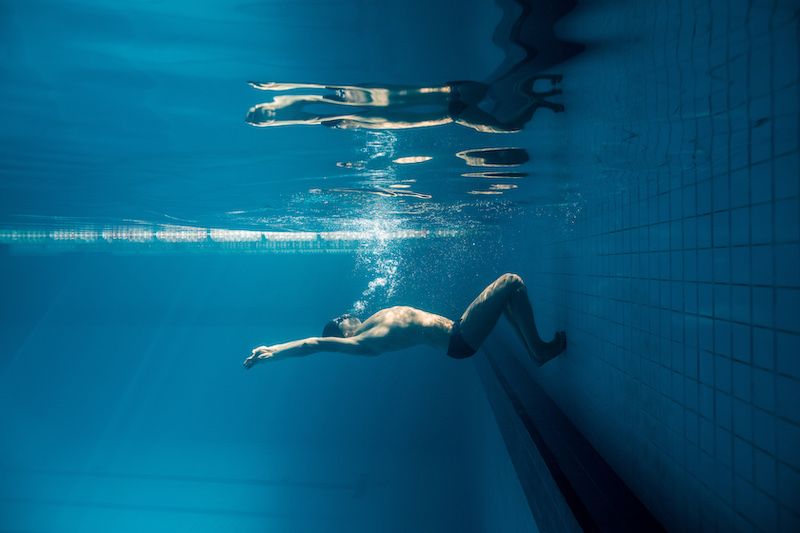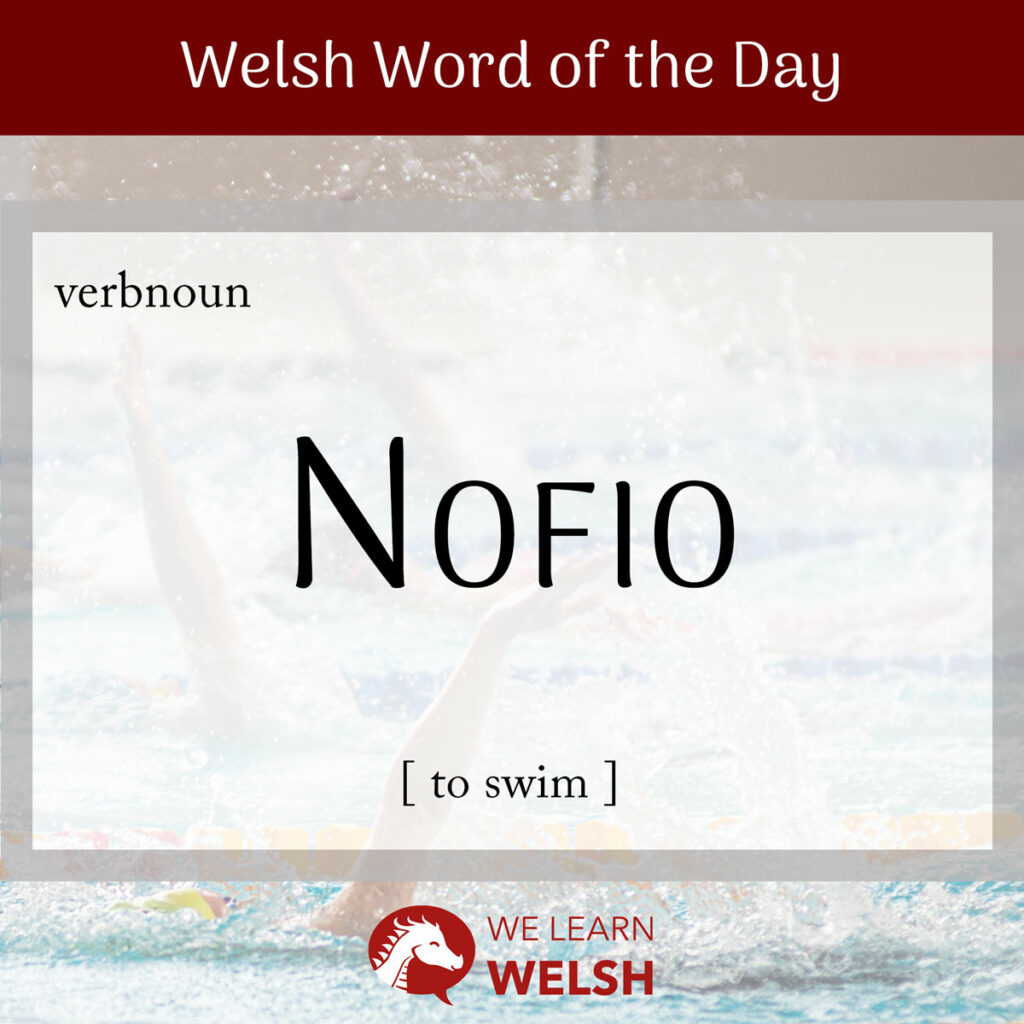Swimming is well known as one of the best forms of exercise for overall fitness, improving iechyd cardiofasgwlaidd (cardiovascular health) and strengthening cyhyrau (muscles) whilst also being relaxing and low impact. The Welsh word for this satisfying pastime is nofio.
nofio
to swim
Nofio comes from the Middle Welsh noun nawf. It can function as either a verb (swimming, to swim) or an uncountable masculine noun (the act of swimming, a swimming stroke). A swimmer is a nofiwr.
There is also the word nofiad, meaning a swim. But it’s not used that much. If you wanted to say to go for a swim, you would just say mynd i nofio (to go to swim).
Though nofio doesn’t mutate, it does of course conjugate, to show who you’re talking about and what tense the sentence is in. Here are some of the most useful colloquial conjugations of this word:
| Future | Conditional | Past | |
| First person singular | Nofia i I will swim | Nofiwn i I would swim | Nofiais i I swam |
| First person plural | Nofiwn ni We will swim | Nofien ni We would swim | Nofion ni We swam |
| Second person singular / informal | Nofi di You will swim | Nofiet ti You would swim | Nofiaist ti You swam |
| Second person plural / formal | Nofiwch chi You will swim | Nofiech chi You would swim | Nofioch chi You swam |
| Third person singular | Nofith o/e/hi He/she will swim | Nofiai fo/fe/hi He/she would swim | Nofiodd o/e/hi He/she swam |
| Third person plural | Nofian nhw They will swim | Nofien nhw They would swim | Nofion nhw They swam |
Remember that there are a lot of dialectical variants.
There are also a few variants on the root word that have historically been more common in very specific areas of Wales, largely communities in the South – though not the South as a whole. For example, take mofiad and moifad, which come from ymnofio, an archaic reflexive verb which literally means to swim oneself and would have been used to talk about bathing.
However, as Welsh becomes more and more standardised, these words become less common, so nofio is the best choice if you want to be understood across the country. If any of you come from areas that still use mofiad, ofiad or noifad, we’d love to hear from you!
As well as variants on the word, there are variants on nofio itself. A specific swimming stroke is just a strôc, adapted from the English.
Here are some of the most popular strociau:
- nofio yn eich blaen / ymlusgo = to swim front crawl
- nofio ar y cefn = to swim backstroke
- nofio ar y brest / nofio broga = to swim breaststroke
- nofio ar yr ochr = to swim sidestroke
- nofio pili-pala / nofio glöyn byw = to swim butterfly
- nofio morlo = to swim seal
- nofio fel ci = to swim doggy-paddle
I always like nofio broga (literally frog-swimming), and I love dal fy ngwynt (holding my breath) for as long as possible danddwr (underwater). And sometimes it’s nice to just arnofio (float) in the dŵr (water) and feel at peace.
On the other hand, I’m no good at plymio (diving). And I certainly couldn’t do nofio pili-pala to save my life!
Mae fy mabi yn cael dysgu nofio yn y ganolfan hamdden.
My baby is being taught to swim at the leisure centre.
One of my favourite places to swim has always been the môr (sea) at Llangrannog, where my teulu (family) went for gwyliau haf (summer holidays) when I was a child. My siblings and I loved to play in the tonnau (waves) and practise our strociau, although I often got told off for nofio too far out.
Since Cymru (Wales) has over 500 traethau (beaches), it’s an excellent country to live in or visit if you do like nofio yn y môr. The Visit Wales gwefan (website) has some good information on nofio gwyllt (wild swimming) in Wales, including recommended spots and guidance on safety.
Whether your desired destination is y môr, an afon (river), a llyn (lake), or just the local pwll nofio (swimming pool), you’re going to need some gear.
- gwisg nofio = swimming costume
- trywsus nofio / trwser nofio = swimming trunks
- bicini = bikini
- siwt wlyb = wetsuit
- gogls / sbectol ddŵr = goggles
- cap nofio = swimming hat
For more adventurous danddwr pastimes like sgwba-blymio (scuba diving) or snorcelu (snorkelling), you’ll need addition offer (equipment), like a peipen anadlu (breathing tube / snorkel). And Cymru again is a great destination if you’re interested in snorcelu – you could take to the Celtic Deep in Sir Benfro (Pembrokeshire) or explore the dyfroedd (waters) of y Fenai (the Menai Straits) separating Gwynedd and Ynys Môn, for example.
You’re likely to see a lot of gorgeous bywyd gwyllt (wildlife), including of course anifeiliaid nofiadol (swimming animals) like pysgod (fish) and if you’re lucky, morloi (seals). Plus, Cymru is generally a lot safer than other popular spots for sgwba-blymio and snorcelu. As the dŵr is so much colder, there are less dangerous species of morgwn / siarcod (sharks) and sglefrod môr (jellyfish).
Rhuthrodd y môr-grwban bach i’r tonnau i ddechrau nofio.
The baby turtle rushed into the waves to start swimming.
But the use of nofio isn’t restricted to just pobl (people) and anifeiliaid (animals) taking to the dŵr (water). It can also be used in a non-literal sense to say that something is submerged in a hylif (liquid). For example, I like my grawnfwyd (breakfast) to be nofio mewn llaeth (swimming in milk).
Plus, it can come up in expressions, like the English to swim against the stream meaning to go against the prevailing belief or trend. This can be translated literally into Welsh as nofio’n erbyn y llif (swimming against the flow).
Now it’s your turn. Are you an avid nofiwr or scared to step foot in the dŵr?


